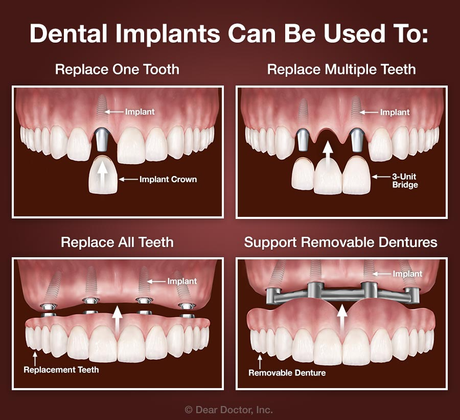10 Simple Techniques For Dental Sense
10 Simple Techniques For Dental Sense
Blog Article
Excitement About Dental Sense
Table of ContentsThe Facts About Dental Sense RevealedMore About Dental SenseSome Known Details About Dental Sense The Only Guide for Dental Sense
are medical tools surgically implanted right into the jaw to restore an individual's capability to chew or their look. They supply support for man-made (fake) teeth, such as crowns, bridges, or dentures. When a tooth is shed as a result of injury or illness, a person can experience difficulties such as quick bone loss, faulty speech, or changes to eating patterns that lead to discomfort.Oral implant systems include an oral implant body and oral implant abutment and might also consist of an abutment addiction screw. Dental implant vs bridge. The dental implant body is operatively inserted in the jawbone in location of the tooth's origin. The oral implant joint is typically affixed to the implant body by the joint fixation screw and prolongs via periodontals right into the mouth to support the attached fabricated teeth
(https://fliphtml5.com/homepage/hegcy)Framework of The Dental Implant System selecting dental implants, talk with your oral service provider about the potential advantages and dangers, and whether you are a candidate for the treatment. Points to think about: Your general health is an important consider establishing whether you are a great candidate for oral implants, the length of time it will require to heal, and for how long the dental implant may remain in place.
Smoking cigarettes might influence the recovery process and lower the long-lasting success of the dental implant. The healing procedure for the implant body might take several months or longer, during which time you usually have a momentary abutment instead of the tooth. the dental implant treatment: Thoroughly adhere to the dental hygiene guidelines given to you by your oral supplier.
Top Guidelines Of Dental Sense
Implant failing can result in the demand for one more procedure to repair or change the dental implant system. Restores the capacity to chew Brings back aesthetic appearance Helps keep the jawbone from reducing because of bone loss Maintains the health of the bordering bone and gums Helps keep surrounding (neighboring) teeth stable Boosts lifestyle Damages to surrounding natural teeth during implant placement Injury to the surrounding cells during surgical treatment, such as sinus opening Injury during surgery (for instance, crack of bordering jawbone) Poor function, such as really feeling like the teeth do not bite together normally A feeling that the tooth is loosened or twisting in position resulting from an abutment screw loosening up Implant body failure (looseness of the dental implant body) as a result of systemic infection, which might be more probable in patients with unrestrained diabetes because of regional infection in bone and gum tissues sustaining the implant body due to delayed healing, which may be more probable in clients who smoke Difficulty cleaning up the gums around the dental implant, causing bad dental hygiene Without treatment gum illness Post-surgical feeling numb because of nerve impingement or damages Constantly alert health and wellness treatment carriers and imaging technicians that you have dental implants prior to any kind of magnetic vibration imaging (MRI) or x-ray treatments.
FDA is not familiar with any type of adverse events reported for MRI or x-ray procedures with dental implants. Oral implants systems are generally made of materials that follow international agreement requirements of the International Company for Standardization (ISO) or ASTM International. These criteria have information of what makes a safe material.

An oral implant is a structure that changes a missing tooth. With screw-like devices, the cosmetic surgeon inserts a dental implant right into the jawbone, and it functions as a support for a fabricated tooth, called a crown. A device called a joint attaches the man-made tooth to the oral implant. The crown is tailor-made to fit the person's mouth and match the color of their teeth.
The Best Guide To Dental Sense
Some people are not eligible for oral implant surgical treatment. It is for dental specialists to operate on people with: acute illnessuncontrollable metabolic diseasebone or soft cells disease or infectionIf these concerns are resolved, an individual can have the surgical procedure. In, dental surgeons avoid operating on people with: If individuals with any one of the above go through dental implant surgical treatment, there is a higher risk of the dental implant falling short.

Oral implant surgery is a customized procedure. It's not the same for everybody. The complying with offers a general overview of what you can expect your dental professional, oral specialist, periodontist or prosthodontist to do: Put the dental implant surgically. Provide you time to heal. Connect the message and final crown, bridge or denture.
Next off, your cosmetic surgeon will very carefully put the dental implant into your jaw. Ultimately, your doctor will certainly rearrange your periodontals and close the laceration with stitches. If your dental implant is near the front of your mouth, your dental expert will make a temporary tooth for you to put on till you heal. In this way, you will not have a void in your smile while you recuperate.
All about Dental Sense
During the recovery phase, your jawbone ought to fuse to the oral implant. This procedure can take anywhere from three to nine months.
Once your implant heals, your dental practitioner can connect the joint (tiny connector message) and your final repair (crown, bridge or denture). This usually takes regarding one hour to finish and might call for a 2nd small surgery. You shouldn't feel any kind of discomfort throughout your dental implant procedure because your supplier will utilize medicine to numb your gum tissues.
Report this page